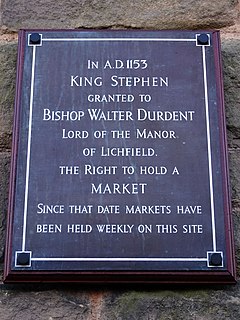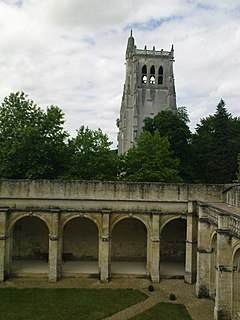Related Research Articles

Ealdred was Abbot of Tavistock, Bishop of Worcester, and Archbishop of York in early medieval England. He was related to a number of other ecclesiastics of the period. After becoming a monk at the monastery at Winchester, he was appointed Abbot of Tavistock Abbey in around 1027. In 1046 he was named to the Bishopric of Worcester. Ealdred, besides his episcopal duties, served Edward the Confessor, the King of England, as a diplomat and as a military leader. He worked to bring one of the king's relatives, Edward the Exile, back to England from Hungary to secure an heir for the childless king.
Leofric was a medieval Bishop of Exeter. Probably a native of Cornwall, he was educated on the continent. At the time Edward the Confessor was in exile before his succession to the English throne, Leofric joined his service and returned to England with him. After he became king, Edward rewarded Leofric with lands. Although a 12th-century source claims Leofric held the office of chancellor, modern historians agree he never did so.

Stigand was an Anglo-Saxon churchman in pre-Norman Conquest England who became Archbishop of Canterbury. His birth date is unknown, but by 1020 he was serving as a royal chaplain and advisor. He was named Bishop of Elmham in 1043, and was later Bishop of Winchester and Archbishop of Canterbury. Stigand was an advisor to several members of the Anglo-Saxon and Norman English royal dynasties, serving six successive kings. Excommunicated by several popes for his pluralism in holding the two sees, or bishoprics, of Winchester and Canterbury concurrently, he was finally deposed in 1070, and his estates and personal wealth were confiscated by William the Conqueror. Stigand was imprisoned at Winchester, where he died without regaining his liberty.
John de Gray or de Grey was an English prelate who served as Bishop of Norwich, and was elected but unconfirmed Archbishop of Canterbury. He was employed in the service of Prince John even before John became king, for which he was rewarded with a number of ecclesiastical offices, culminating in his pro forma election to Norwich in 1200. De Gray continued in royal service after his elevation to the episcopate, lending the King money and undertaking diplomatic missions on his behalf. In 1205 King John attempted to further reward de Gray with a translation to the archbishopric of Canterbury, but a disputed election process led to de Gray's selection being quashed by Pope Innocent III in 1206.
Thurstan or Turstin of Bayeux was a medieval Archbishop of York, the son of a priest. He served kings William II and Henry I of England before his election to the see of York in 1114. Once elected, his consecration was delayed for five years while he fought attempts by the Archbishop of Canterbury to assert primacy over York. Eventually, he was consecrated by the pope instead and allowed to return to England. While archbishop, he secured two new suffragan bishops for his province. When Henry I died, Thurstan supported Henry's nephew Stephen of Blois as king. Thurstan also defended the northern part of England from invasion by the Scots, taking a leading part in organising the English forces at the Battle of the Standard (1138). Shortly before his death, Thurstan resigned from his see and took the habit of a Cluniac monk.
Geoffrey Ridel was the nineteenth Lord Chancellor of England, from 1162 to 1173.
Hugh de Puiset was a medieval Bishop of Durham and Chief Justiciar of England under King Richard I. He was the nephew of King Stephen of England and Henry of Blois, who both assisted Hugh's ecclesiastical career. He held the office of treasurer of York for a number of years, which led him into conflict with Henry Murdac, Archbishop of York. In 1153, Hugh was elected bishop of Durham despite the opposition of Murdac.

Cynesige was a medieval English Archbishop of York between 1051 and 1060. Prior to his appointment to York, he was a royal clerk and perhaps a monk at Peterborough. As archbishop, he built and adorned his cathedral as well as other churches, and was active in consecrating bishops. After his death in 1060, the bequests he had made to a monastery were confiscated by the queen.
Henry Murdac was abbot of Fountains Abbey and Archbishop of York in medieval England.
William Walcher was the bishop of Durham from 1071, a Lotharingian and the first Prince-bishop. He was the first non-Englishman to hold that see and an appointee of William the Conqueror following the Harrying of the North. He was murdered in 1080, which led William to send an army into Northumbria to harry the region again.
Gerard la Pucelle was a peripatetic Anglo-French scholar of canon law, clerk, and Bishop of Coventry.
Ælfric of Abingdon was a late 10th-century Archbishop of Canterbury. He previously held the offices of abbot of St Albans Abbey and Bishop of Ramsbury, as well as likely being the abbot of Abingdon Abbey. After his election to Canterbury, he continued to hold the bishopric of Ramsbury along with the archbishopric of Canterbury until his death in 1005. Ælfric may have altered the composition of Canterbury's cathedral chapter by changing the clergy serving in the cathedral from secular clergy to monks. In his will he left a ship to King Æthelred II of England as well as more ships to other legatees.
Duduc was a medieval Bishop of Wells.
Æthelwold was the first Bishop of Carlisle in medieval England.
Peter was a medieval cleric. He became Bishop of Lichfield in 1072, then his title changed to Bishop of Chester when the see was moved in 1075.
Robert de Limesey was a medieval cleric. He became Bishop of Chester in 1085, then his title changed to Bishop of Coventry when the see was moved in 1102.
Roger de Clinton was a medieval Bishop of Coventry and Lichfield. He was responsible for organising a new grid street plan for the town of Lichfield in the 12th century which survives to this day.

Walter Durdent was Bishop of Coventry from 1149 to 1159.
Richard Peche was a medieval Bishop of Lichfield.

Hugh Nonant was a medieval Bishop of Coventry in England. A great-nephew and nephew of two Bishops of Lisieux, he held the office of archdeacon in that diocese before serving successively Thomas Becket, the Archbishop of Canterbury and King Henry II of England. Diplomatic successes earned him the nomination to Coventry, but diplomatic missions after his elevation led to a long delay before he was consecrated. After King Henry's death, Nonant served Henry's son, King Richard I, who rewarded him with the office of sheriff in three counties. Nonant replaced his monastic cathedral chapter with secular clergy, and attempted to persuade his fellow bishops to do the same, but was unsuccessful. When King Richard was captured and held for ransom, Nonant supported Prince John's efforts to seize power in England, but had to purchase Richard's favour when the king returned.
References
- Barlow, Frank (1979). The English Church 1000–1066: A History of the Later Anglo-Saxon Church (Second ed.). New York: Longman. ISBN 0-582-49049-9.
- Barlow, Frank (1988). The Feudal Kingdom of England 1042–1216 (Fourth ed.). New York: Longman. ISBN 0-582-49504-0.
- Douglas, David C. (1964). William the Conqueror: The Norman Impact Upon England. Berkeley, CA: University of California Press.
- Fryde, E. B.; Greenway, D. E.; Porter, S.; Roy, I. (1996). Handbook of British Chronology (Third revised ed.). Cambridge, UK: Cambridge University Press. ISBN 0-521-56350-X.
- Huscroft, Richard (2005). Ruling England 1042–1217. London: Pearson/Longman. ISBN 0-582-84882-2.
- Knowles, David (1976). The Monastic Order in England: A History of its Development from the Times of St. Dunstan to the Fourth Lateran Council, 940–1216 (Second reprint ed.). Cambridge, UK: Cambridge University Press. ISBN 0-521-05479-6.
- Powell, J. Enoch; Wallis, Keith (1968). The House of Lords in the Middle Ages: A History of the English House of Lords to 1540. London: Weidenfeld and Nicolson. OCLC 463626.
- Williams, Ann (2000). The English and the Norman Conquest. Ipswich, UK: Boydell Press. ISBN 0-85115-708-4.